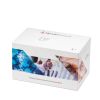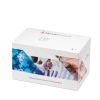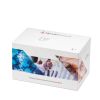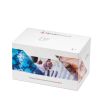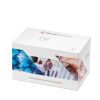LAL Chromogenic Endpoint Assay - HIT302
Quantity
3 plates
Catalog #
HIT302
1.205,00 €
Bacterial endotoxin, like lipopolysaccharide (LPS), is a fever-producing by-product of gram-negative bacteria commonly known as pyrogen.
The principle of the test is based on the fact that bacteria cause intravascular coagulation in the American horseshoe crab, Limulus polyphemus. The agent responsible for the clotting phenomena resided in the crab's amoebocytes, or circulating blood cells, and that pyrogen (bacterial endotoxin) triggered the turbidity and gel-forming reaction enzymatically. Thus, endotoxin causes an opacity and gelation in Limulus amebocyte lysate (LAL), which is based on an enzymatic reaction.
The simplicity and economy of the LAL chromogenic endpoint assay encourages the testing of various biologicals (including sera), devices, (air)filters and tissue culture medium for the presence of harmful levels of endotoxin.
| Datasheet URL | https://www.hycultbiotech.com/wp-content/uploads/2023/05/SDS-HIT302.pdf |
|---|---|
| Quantity | 3 plates |
| Quantity | 3 plates |
| Standard range | The kit has a measurable concentration range of 0.04 to 10.0 EU/ml |
| Detection level | The kit has a minimum detection limit of 0.04 EU/ml. |
| Working volume | 50 µl/well |
| Species | n/a |
| Application | The LAL assays are to be used for the in vitro quantitative determination of various biological fluids (including sera), devices, (air)filters and tissue culture medium. |
| Principle | The LAL assay is an enzyme-based assay with a working time of 20-45 minutes. The efficient format of 3 plates allows free choice of batch size for the assay. Samples and standards are incubated with LAL reagent. The enzymatic reaction, triggered by endotoxin, will cause a yellow color to develop upon cleavage of the chromophore, p-nitroaniline. The enzymatic reaction is stopped by the addition of acetic acid. The absorbance at 405 nm is measured with a spectrophotometer. A standard curve is obtained by plotting the absorbance (linear) versus the corresponding concentrations of the E. coli standards (log). The endotoxin concentration of samples, which are run concurrently with the standards, can be determined from the standard curve. |
| Storage and stability | Product should be stored at 4 °C. Under recommended storage conditions, product is stable for at least six months. |
| Precautions | For research use only. Not for use in or on humans or animals or for diagnostics. It is the responsibility of the user to comply with all local/state and Federal rules in the use of this product. Hycult Biotech is not responsible for any patent infringements that might result with the use of or derivation of this product. All materials coming in contact with specimen or test material should be endotoxin-free. |
| References | 1. Kuula, H et al; Local and Systemic Responses in Matrix Metalloproteinase 8-Deficient Mice during Porphyromonas gingivalis-Induced Periodontitis. Infection and Immunity 2009, 77: 850 2. Nymark, M et al; Serum Lipopolysaccharide Activity Is Associated With the Progression of Kidney Disease in Finnish Patients With Type 1 Diabetes. Diabetes Care 2009, volume 32 9: 1689 3. Demberg, T et al; Strong viremia control in vaccinated macaques does not prevent gradual Th17 cell loss from central memory. Vaccine 2011, 29: 6017 4. Kalambokis, G et al; Circulating endotoxin and interleukin-6 levels are associated with Doppler-evaluated pulmonary vascular resistance in cirrhotic patients. Hepatol Int 2012 |
| Disease | Infectious diseases |
| Application assays: | The LAL assays are to be used for the in vitro quantitative determination of various biological fluids (including sera), devices, (air)filters and tissue culture medium. |
|---|---|
| Principle: | The LAL assay is an enzyme-based assay with a working time of 20-45 minutes. The efficient format of 3 plates allows free choice of batch size for the assay. Samples and standards are incubated with LAL reagent. The enzymatic reaction, triggered by endotoxin, will cause a yellow color to develop upon cleavage of the chromophore, p-nitroaniline. The enzymatic reaction is stopped by the addition of acetic acid. The absorbance at 405 nm is measured with a spectrophotometer. A standard curve is obtained by plotting the absorbance (linear) versus the corresponding concentrations of the E. coli standards (log). The endotoxin concentration of samples, which are run concurrently with the standards, can be determined from the standard curve. |
| Recovery: | Recovery is evaluated by interference (inhibition/enhancement) testing through spiking a sample or diluted sample with a known concentration of endotoxin and testing for spike recovery in duplicate following the assay procedure. In general, serum samples contain interfering factors. Therefore, we recommend to perform recovery experiments to confirm the reliability of endotoxin detection in serum. For interference testing select a point at or near the middle of the standard curve. The calculated mean amount of endotoxin in the spiked sample, when referenced to the standard curve, must be within 50-200% to be considered free of inhibition or enhancement. Failure to recover the spike within 50-200% indicates sample interference. Further dilute the sample in endotoxin free water until the spike is recovered consistently by the assay. |



